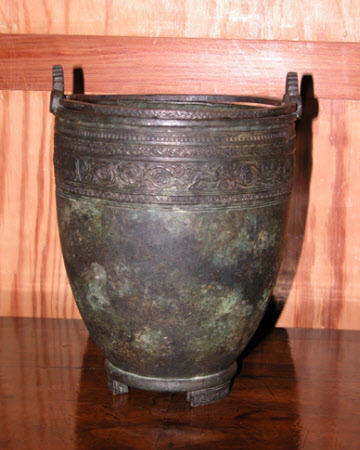A copy of a situla from Pompeii
Italian (Neapolitan) School
Category
Metalwork
Date
c. 1900 - c. 1950
Materials
Bronze
Measurements
217 mm (Height); 162 mm (Diameter); 918 mm (Diameter)
Place of origin
Naples
Order this imageCollection
Anglesey Abbey, Cambridgeshire
NT 515091
Summary
Bronze, a copy of a situla from Pompeii, Italian (Neapolitan) School, c. 1900-50. A bronze copy of a situla, a type of bucket-like vessel used by the Romans to mix wine. This is a close copy of a well-known original situla found in Pompeii and now in the Archaeological Museum in Naples. It is ovoid in shape, on an integral rim and three small feet, the sides decorated with a frieze with palmette and scrolling decoration, among which may be seen figures of animals, two pairs of bulls before libation altars, between them springing deer. On each side of the rim is a scrolled palmette, which holds a pair of hemi-spherical handles. Made in Naples between c. 1900 and 1950.
Full description
Regarded as the gift of the wine god Bacchus, Romans loved to drink wine which thus was an essential part of any banquet (for the Romans and wine, see Roberts 2013, pp. 241-45; Roberts 2019, pp. 147-49). Wine was stored in large clay amphorae, but it was not considered proper in good society to drink it directly from the amphora. It had to be mixed before drinking, a process done in the ovoid vessel known as the situla. Wine would be mixed with water as well as other ingredients such as honey and spices, depending on the course at which it would be served. The mixed wine would be poured from the situla into jugs known as askoi. The original situla, around twice the height of the copy at Anglesey Abbey, is in the Museo Archeologico Nazionale in Naples (Inv. MANN 68866; height 41.5 cm.; width 33 cm; Roberts 2013, p. 241, fig. 292). The situla is one of two well-known examples from Herculaneum and Pompeii, the other with an inlaid inscription Corneliaes Chelidonis, Cornelia Chelidone, probably the name of the object’s owner (Museo Archeologico Nazionale, Naples, Inv. MANN 68854; height 44 cm; Aßkamp 2007, pp. 72-73, fig. 9 & pp. 249-50, no. 6.15; Roberts 2019, pp. 147, 263, no. 136, wrongly illustrated figs. 158-59 with MANN 68866). These objects are inspired by similar objects made in Capua in the fifth century B.C. as well as by earlier Greek design motifs. The copy of the situla from Pompeii was almost certainly cast in Naples, in one of the many foundries that produced reproductions of works of art found at Herculaneum and Pompeii, for sale to tourists and decorators (for other reproductions, see a marble table support at Anglesey Abbey (NT 516603) and a bust of Lucius Caecilius Iucundus at Ightham Mote (NT 825661). The model does not appear in the catalogues of the Chiurazzi foundry, which was the principal manufactory in Naples, offering a vast range of copies in bronze and other materials. Jeremy Warren 2020
Provenance
Bequeathed to the National Trust by Huttleston Rogers Broughton, 1st Lord Fairhaven (1896-1966) with the house and the rest of the contents.
Credit line
Anglesey Abbey, The Fairhaven Collection (The National Trust)
Makers and roles
Italian (Neapolitan) School, founder
References
Roberts 2013: Paul Roberts, Life and Death in Pompeii and Herculaneum, London 2013 Robert 2019: Paul Roberts (ed.), Last Supper in Pompeii, Oxford 2019 Aßkamp 2007: Rudolf Aßkamp et al., Luxus und Dekadenz. Römisches Leben am Golf von Neapel, exh. cat., LWL-Römermuseum, Mainz 2007
